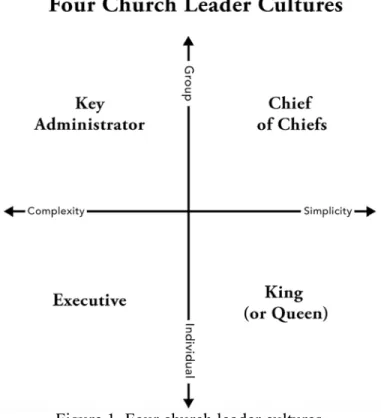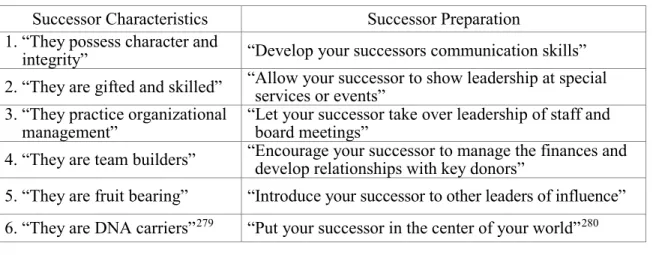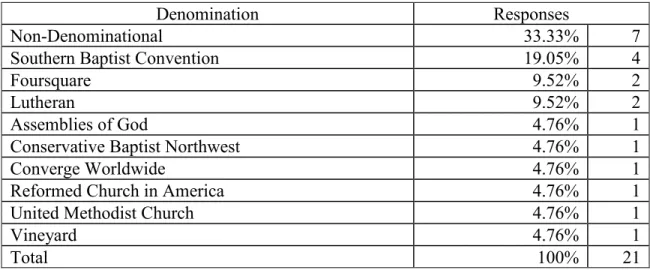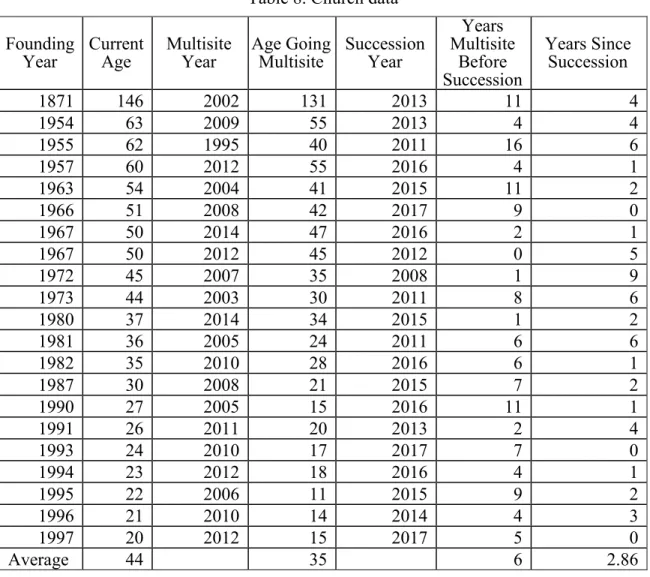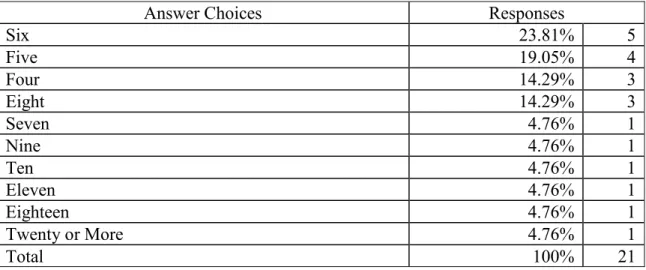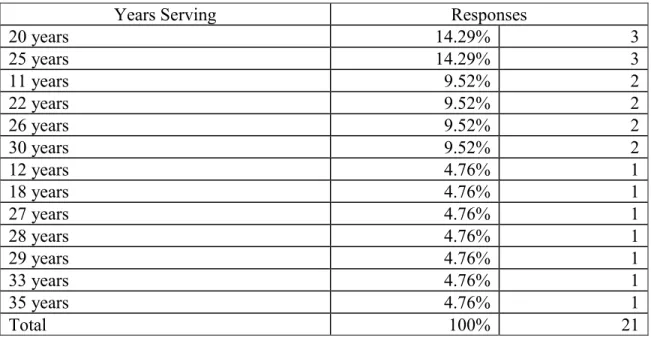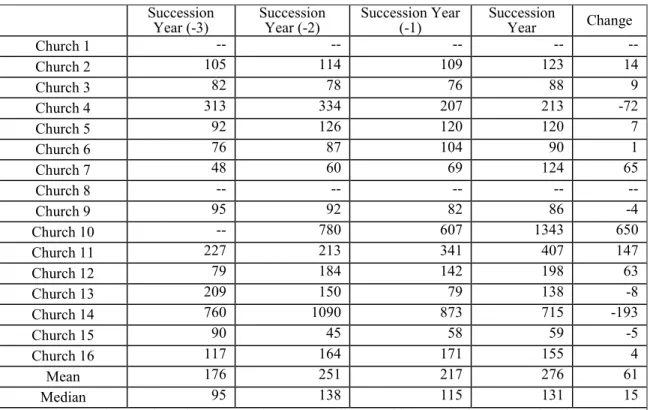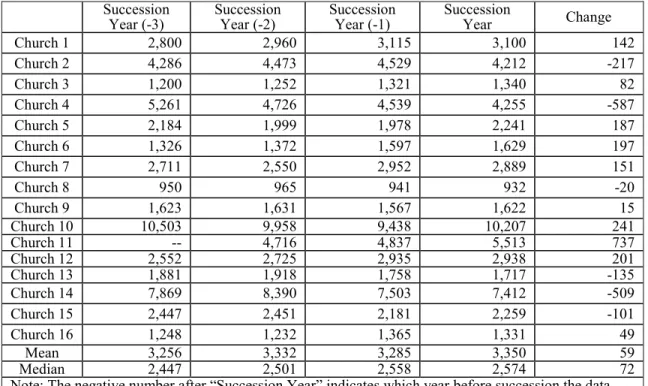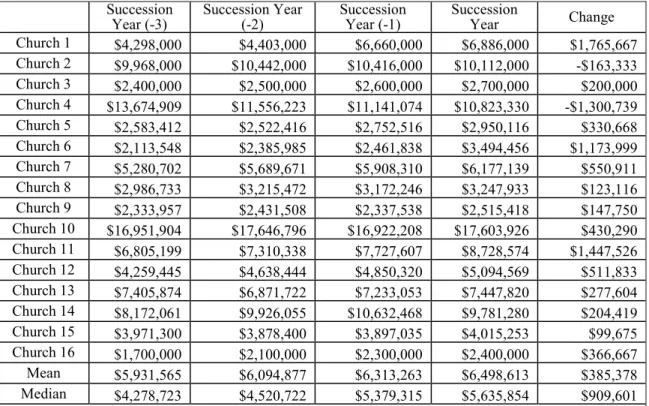24Christopher Barton Kouba, “Role of the Campus Pastor: Responsibilities and Practices in Multisite Churches” (D.Min. project, The Southern Baptist Theological Seminary, 2014), 1. Multisite churches are becoming part of the Northern Baptist landscape American Church for the foreseeable future.
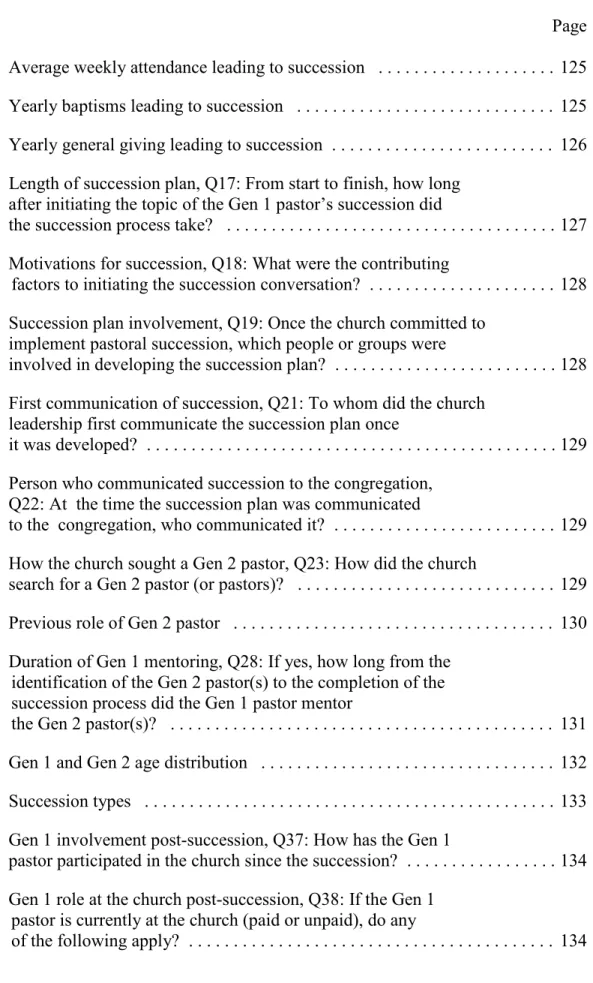
Survey Data
With the consent of the church, the survey was administered to one of the following individuals: (1) generation 1 pastor, (2) generation 2 pastor, (3) senior pastoral staff who were part of the succession process, or (4) governing board members who was part of the succession process. Additionally, field testing a survey on such a small population can remove valuable data from the final version of the survey.
Delphi Panel
Consensus on each statement was defined as 70 percent or more of the panel rated the item as "3" or higher. However, one of the most important aspects to the longevity of the multi-establishment church is how it transfers power from one pastor to another.
LITERATURE REVIEW
This selflessness on the part of the church's leaders contributed to the spread of the gospel throughout the Mediterranean world. Stepp, Leadership Succession in the World of the Pauline Circle, New Testament Monographs 5 (Sheffield: Sheffield Phoenix. With these principles in mind, the trend of the multisite church and the literature on leadership succession can be examined.
Some argue that the Church of the New Testament era consisted of several branches in many cities. Revolution, 27, writes of the multi-site church: “In short, multi-site encapsulates the current approach of the church in which geography is no longer the determining factor. This section shows that the most well-known works on the multisite church—and the growing research base on multisite churches—have not addressed the long-term sustainability of the multisite church.
106 Dave and Jon Ferguson's father, Earl, advocated even earlier expressions of the multi-place church. Students have published dissertations on the multifaceted church, and independent researchers have explored various aspects of the multifaceted church. In a church setting, this is not just the responsibility of the pastor and elders—the process involves many others.
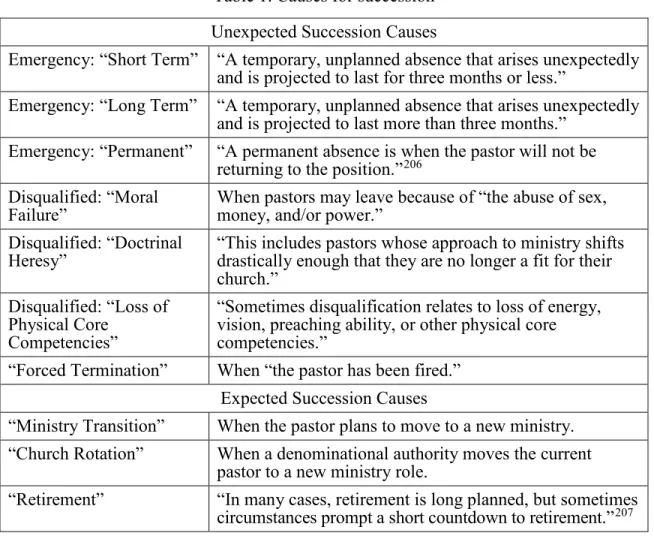
RESEARCH DESIGN
This chapter describes a two-phase sequential mixed methods study that served to answer the research questions. Creswell and Plano Clark would add that the "central premise" of mixed methods "is that using quantitative and qualitative approaches in combination produces a better result." Plano Clark, Designing and Conducting Mixed Methods Research (Thousand Oaks, CA: Sage Prior to the process in this chapter, the research methodology was submitted for approval to the Ethics Committee of The Southern Baptist Theological Seminary.
The research here is considered low risk to humans and all participants entered their part of the project with informed consent. 4 There is precedent for multi-site academic research to use surveys created in consultation with experts to explore specific research questions. The output of Phase 1 was a sample of multi-location churches and the methods these churches used to transition through pastoral succession, and certain pre- and post-succession metrics. 5.
The first step of Phase 1 involved the simultaneous process of identifying the population and completing the survey.
Population discovery and survey formation. The first step of phase 1 involved a concurrent process of discovering the population and finalizing the survey
Snowball sampling is the process of recruiting people within or related to a population who then provide examples of the phenomenon being studied (or potential examples of the phenomenon). These contacts were then emailed with an introduction to the study, examples of follow-up, and a request for names of churches.12 In most cases, the contacts did not reply or replied that they were interested in the study but unfortunately had no examples. . Following up on these churches and succession stories led to a potential list of 42 churches that fit the definition of the.
However, the finalization of a survey of this magnitude required experts in the field of the multisite church and/or pastoral succession. Fourteen panel members who met the criteria were contacted and agreed to provide feedback on the survey.16 A unique Google Sheet was created for each panel member with an overview of the research questions and a draft of the Multisite Pastor Succession Survey. The purpose of the first round of these surveys was to discover consensus on the most essential survey elements and make any adjustments to the final survey.
After the identification of the church population was finalized21 and the survey was in its final stage.
Participant contact and survey administration. After the identification of the church population was finalized 21 and the survey was in its final
This delay occurred because the survey required metrics that would be difficult to track. Once respondents agreed, the survey was scheduled and a follow-up email was sent informing respondents when they would receive the survey and what information would be useful to have on hand when completing the survey. The survey for each respondent remained open until analysis had to begin and Phase 2 was developed.
The survey concluded with open-ended questions to help better understand specific issues within each follow-up event. This research used Jamus Howell Edwards' Ph.D dissertation on campus pastors in the multisite church as a guide for how to present the survey data.25. Furthermore, items within the survey that sought information on organizational structure (number of campuses, location of campuses, sermon delivery method) were compared to see the approaches to succession used by these churches.
Third, the open-ended responses at the end of the survey were presented and summarized thematically to better understand the lessons these respondents learned in their succession processes.
Delphi Panel on Succession
Churches that provided all or most of the seven years of required data were considered for analysis. The four categories were developed through survey design for phase 1 and interaction with pastors in phase 2. For panel round 1, a questionnaire was formulated based on (1) the continuity literature and (2) survey results.
At the end of the second round survey, the data were compiled into an Excel spreadsheet. The information found in phase 1 represented as much of the population as possible, however the exact number of multi-site churches that have gone through the continuum was difficult to calculate. The specific limitations of the research population and the specific qualifications of the expert panel in phase 2 limit generalizability in three ways.
This feedback resulted in a customized eleven-question survey.7 Simultaneously with the feedback, I confirmed the participation of twelve panelists to join the Delphi.8 Eleven of the 12 panelists.
Succession Survey
Length of succession plan, Q17: From start to finish, how long did the succession process last after the Gen 1 pastor succession topic began. Including those who chose “other,” the responses largely showed a concerted effort on behalf of Gen 1/Gen 2 pastors and church leaders. One spoke about the life span of a Gen 1 pastor and the need to plant a church.
When it comes to internal succession, the first generation pastor mentoring the second generation leadership becomes an important aspect of the succession process. In addition, seven of the 35 churches (20 percent) had some type of family relationship with the Gen 1 pastor. Fourteen churches responded to question 38, which asked how the Gen 1 pastor remained involved (in a paid or unpaid role).
We have ensured the financial stability of the Gen 1 Pastor through open dialogue and clear agreement prior to succession.

Delphi Panel on Best Practices
Elements of succession churches would change, Q46: Now that the original succession process is complete, what elements of your church. I serve or have served as a board member OR member of a pastoral leadership team for a generation. Using information from the open-ended questions and analysis of 20 of the 21 phase 1 surveys, 11 questions were prepared to be sent to the .
Using information from the open-ended questions, as well as analysis of 20 of the 21 surveys from phase 1, 11 questions were drafted to send to the
If internal succession, Gen 1 pastors must give Gen 2 pastor(s) exposure to the congregation before succession. How important are the following items when it comes to helping Gen 1 pastors consider succession. How important are the following items when it comes to helping Gen 1 pastors personally prepare for succession.
How important are the following items when it comes to the group(s) of people with whom Gen 1 pastors must develop a succession plan. How important are the following items when it comes to where Gen 1 pastors should focus. How important are the following items when it comes to how Gen 2 pastors the.
Q8: Do you agree or disagree that the following practices are valuable when it comes to how Gen 2 pastors can honor the legacy of the Gen 1 pastor.
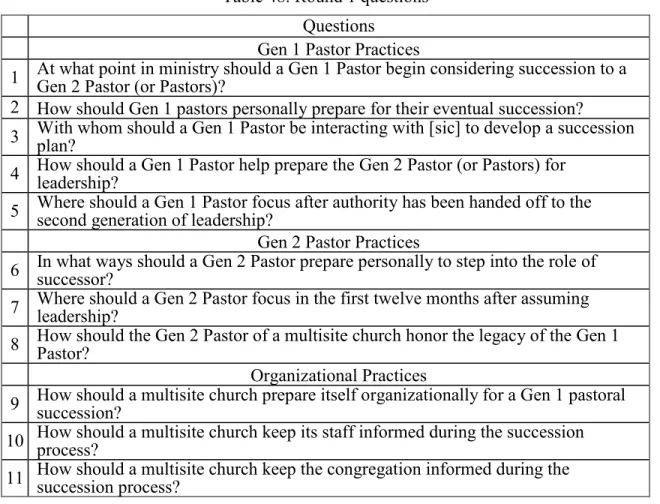
The diversity of churches that participated in Phase 1 of the research led to a good group of panelists asking to participate in Phase 2's Delphi. Although there were several strengths and weaknesses of the study (outlined herein), this study is one of the first of its kind in a field that will only need further research in the coming years. The results are primary, but these findings offer several areas of application for churches and church leaders.
CONCLUSIONS
It should be noted that, along with implication 10, phase 2 best practices support most of the implications. Along with the length of the plan, however, the age of the Gen 1 pastor in succession must be considered. Combine this information with practice 2.015 from phase 2 of the study and the data only strengthens the case that succession planning goes beyond the actual transfer of leadership.
Part of the reason for a longer succession perspective is to create a smooth and stable process, and multisite churches focus on this during their succession. The most common previous staff role for the Gen 2 chaplain was a campus chaplain, followed by an executive chaplain—roles that often have a high degree of. Keller notes, “The difference between how churches of 100 and 1,000 operate can be much greater than the difference between a Presbyterian and a Baptist church of the same size.
Being a multinational church is part of the core identity of the organization and, therefore, unchangeable.
